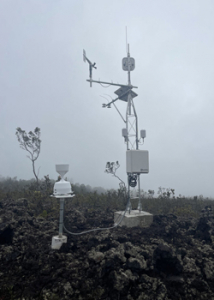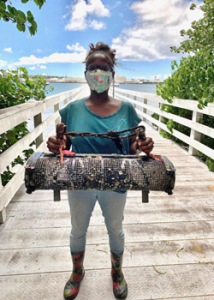
To improve water resiliency in the state, the U.S. Department of Defense Naval Facilities Engineering Expeditionary Warfare Center (NAVFAC EXWC) has invested $300,000 toward a new partnership with the University of Hawaiʻi and others to explore new ways to steward, sustain and reimagine water resources in Hawaiʻi through the Hoʻolana Water Resilience Prize Challenge.
The pilot program was launched in fall 2023 by the UH Office of Innovation and Commercialization and National Security Innovation Network as part of their Innovation Challenge initiative. Two of 13 proposed water resilience solutions were selected for further development. One project employs analytical and machine learning image analysis to detect cloud immersion in Hawaiʻi’s tropical cloud forests (tropical or subtropical forests that are frequently covered in low-lying clouds and mist, creating a persistently wet environment). The other is exploring the potential of oyster aquaculture to improve Pearl Harbor’s water quality and ecosystems. They each received $75,000 in seed funding and mentorship.
Detecting cloud immersion through machine learning analysis

Between 800–3,500 meters in elevation, tropical montane cloud forests are tropical ecosystems characterized by frequent ground-level cloud immersion or fog. Cloud droplets collecting on vegetation is an important source of water in these forests. However, unlike rainfall, the phenomenon of fog meteorology and its interaction with vegetation is still misunderstood and understudied.
A team from the UH Mānoa Water Resources Research Center is working on using machine learning to detect fog and estimate cloud water content from camera images. This low-cost, image-based solution aims to capture near real-time cloud immersion data and enhance researchers’ understanding of fog and its impact on montane regions in Hawaiʻi.
“By using cameras as a low-cost approach for estimating the availability of cloud water in tropical montane cloud forests, we hope to better monitor spatial and temporal cloud immersion patterns across diverse geographies and ecosystems,” said Dylan Giardina, who is part of the team’s research staff. “This represents an important first step in beginning to understand how much water is intercepted by vegetation, developing wall-to-wall climate maps for cloud immersion, and understanding how cloud water availability might be impacted by climate change.”
Restoring natural habitats of Pearl Harbor

A team from UH Hilo Pacific Aquaculture and Coastal Resources Center and its community partners are identifying opportunities for using oyster bivalves to improve water quality and habitats in Pearl Harbor. As suspension feeders, oyster bivalves ingest and filter out excess phytoplankton resulting from run-off from terrestrial sources like nitrogen and phosphorus. They also help settle sediment from erosion, helping to maintain water clarity.
“Wai Momi was once a majestic estuary, rich with biodiversity,” said Rhiannon Tereariʻi Chandler-ʻĪao, UH Hilo aquaculture policy and extension specialist and former Waiwai Ola Waterkeepers Hawaiian Island executive director. “So much of its natural ecosystems have been transformed or lost; it’s hard to find even one pearl oyster in the harbor now. It’s no surprise that water quality is an issue.”
Next steps
Both teams will continue to work with NAVFAC EXWC through the end of the year, and plan to present research updates to government, industry and venture capital communities early next year to determine further development and possible acquisition opportunities.
For more, see this Noelo story. Noelo is UH’s research magazine from the Office of the Vice President for Research and Innovation.

